REU Past Students
2023 2022 2021 2019 2018 2017 2016 2015 2014 2013 2012 2011
2022
-
Thiago Arnaud - Mechanical Engineering, Florida International University
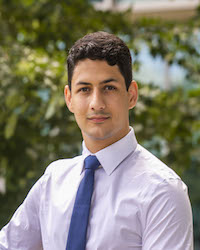 LinkedIn
LinkedIn
Educational Institution: Florida International University
List of Mentors: Dr. Josh Caldwell & Guanyu Lu
Program: NSF REU
Research Project: Filterless Infrared Chemical Sensing with Narrowband Thermal Emitters
Poster: NSF REU Thiago Arnaud Poster
Research Abstract: A plasmon polariton is a quasiparticle made from the coupling of a photon with coherently oscillating free carriers. A TAMM plasmon mode is where a plasmon polariton is induced between a distributed Bragg reflector (DBR) and a conductive surface, which provides a significant reduction in spectral linewidth. Here, we implement a machine-learning algorithm to inversely design the structure of the aperiodic DBR and the carrier concentration of the doped CdO, an n-type semiconductor that we use as the conductive layer to support the TAMM plasmon. Due to the tunability of these structures, they can be designed for narrow absorption and thus, thermal emission peaks at arbitrary spectral position, linewidth and amplitude. This attribute allows for the design of selective infrared sources for chemical sensing, which targets the emission to match the vibrational mode of a desired molecule. Commercially, chemical sensing techniques are limited to one target molecule per device due to the dependence of a bandpass filter to eliminate other frequencies where molecules not of interest absorb. By implementing a TAMM-emitter-based sensor, we demonstrate its viability for filterless non-dispersive infrared sensing featuring an increase in discrimination for a molecule of interest. Two TAMM emitters were designed, fabricated and tested; one for CO2 and another for CO gas sensing while having a low and indiscriminate absorption of the other when present. From plotting the ratio of power decrease due to gas absorption as a function of concentration, the TAMM demonstrated a more accurate sensitivity for concentrations of CO2 than a blackbody with a bandpass filter.
Bio. Thiago Arnaud is a rising junior from Miami, Florida. He studied at Florida International University as a Mechanical Engineer with FIU’s Presidential Merit Scholarship and Florida’s Bright Futures Academic Scholar. He switched majors to Physics due to his curiosity to understand fundamental concepts. He is now enrolled at University of Florida for a Bachelor of Science in Physics. In the Summer of 2021, he participated in the VINSE REU under Dr. Joshua Caldwell on a robust method of thermal imaging. He is working again with Dr. Caldwell this summer to learn more of the skills and research concepts that will prepare him for a successful graduate student career.- Conference Presentation
-T.S. Arnaud, M. He, J. Nordlander, J.P. Maria, and J.D. Caldwell "Multi-Spectral Thermal Imaging with Inversely Designed Optical Filters for Material Recognition" Materials Research Society (MRS) Fall Meeting, Boston, MA, November 2022. - Arnaud was awarded Best Layout at the capstone poster session.
- Conference Presentation
-
Roxanne Hinojosa - Chemical Engineering, University of Oklahoma
LinkedIn
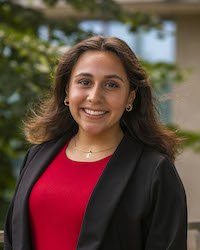
Educational Institution: University of Oklahoma
List of Mentors: Dr. Janet Macdonald & Jeremy Espano, Lexi Koziel
Program: NSF REU
Research Project: Achieving Phase Purity in Nickel Sulfides
Poster: NSF REU Roxanne Hinojosa Poster
Research Abstract: There are seven known phases of nickel sulfide: vaesite, millerite, NiS, godleskvite, Ni7S6, polydymite, and heazlewoodite. Understanding how to obtain one phase over the other would allow for more reproducible, synthetic control as well as obtain more diverse materials for a wider range of applications such as catalysis and semiconductors. Here we aim to obtain each allotrope of nickel sulfide in its phase pure form by using various chemical tools and methods to manipulate the synthesis of these phases. By changing the ratio of precursor to nickel (II) stearate, the solvent, the substituted thiourea used in the reaction, the time of the reaction, and the injection temperature, we were able to obtain vaesite in its pure form, millerite, NiS, and polydymite. By systematically changing these aspects of the synthesis, we were able to understand how the nucleation and transformations of these phases happen, such as the transformation of vaesite to polydymite, and the co-nucleation of millerite and NiS. Using this knowledge will enable the synthesis of uncommon and rare phases of the nickel sulfide family.
Bio. Roxanne Hinojosa hails from Lewisville, Texas, and is a rising sophomore at the University of Oklahoma-Norman majoring in Chemical Engineering and minoring in Computer Science. While she attended Marcus High School in Flower Mound, Texas, she was a part of the National Honor Society, Spanish Honor Society, Science Honor Society, and was an athlete on the cheer team for all four years. Currently, she is a teaching assistant and tutor in the Diversity and Inclusion program at the University of Oklahoma where she assists in the education of culturally and socio-economically diverse freshmen. In her free time, she enjoys partaking in social events hosted by the Society of Women Engineers. -
Levi Hoogendoorn - Materials Science and Engineering, Northwestern University
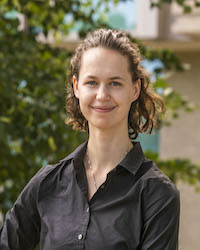 LinkedIn
LinkedIn
Educational Institution: Northwestern University
List of Mentors: Dr. Josh Caldwell & Mingze He
Program: NSF REU
Research Project: Controlling Light Propagation at the Nanoscale in Confined Molybdenum Trioxide (MoO3) Nanobelts
Poster: NSF REU Levi Hoogendoorn Poster
Research Abstract: Light is comprised of electromagnetic waves characterized with defined frequencies and wavelengths. The wavelength determines the length scale of the light and is dependent upon the material through which it propagates. Due to the long free-space wavelengths associated with infrared (IR) light, the realization of nanoscale optical components is challenging, with flat and sub-diffractional optical components promising advances in imaging, communications, sensing, and light sources. The nanoscale confinement of this long-wavelength IR light can be achieved through the formation of polaritons – excitations in materials that result from the interaction of light and coherently oscillating charges. Polaritons exhibit much smaller wavelengths in the materials that support them, enabling us to achieve subdiffractional control of light and overcome some of these challenges. Of the numerous types of polaritons, hyperbolic polaritons exist in highly anisotropic materials, where the dielectric permittivity tensor is opposite in sign along different crystal axes. In these materials, such as molybdenum trioxide (MoO3), the polaritons can only propagate along certain in-plane directions at any given frequency. Here, we seek to enable the propagation of polaritons along the normally “forbidden axis” within MoO3, which occurs within specific spectral bands. From electromagnetic simulations, such propagation is anticipated to become allowed within narrow MoO3 nanobelts (< 500 nm width). We aim at experimentally verifying this. We first fabricate narrow MoO3 samples with the focused ion beam, an instrument which irradiates a sample with heavy ions to mill away material. Then, we carry out scattering-type scanning near-field optical microscopy (s-SNOM) experiments to visualize the propagation of polaritons, including the wavelength and direction. Such work furthers our fundamental understanding of polaritons in complex anisotropic materials and enables us to work towards advance wave-guiding and on-chip photonics and sensing applications in IR optics.
Bio. Levi is a rising junior at Northwestern University, studying materials science and Integrated Science (an honors, interdisciplinary program that covers math, biology, chemistry, and physics). At Northwestern, she has participated in research in Professor Hersam’s nanoscale group, working within the field of 2D materials. She was awarded the McCormick Undergraduate Research Grant last summer, as well as awards for her coursework, including the Outstanding Materials Science and Engineering (MSE) Sophomore award in Materials Science, the Excellence in Mathematics by a First Year award, and numerous High Honors (4.0 GPA in the academic quarter) recognitions. Levi is also a member of Northwestern’s Division I Fencing Team. As a part of this team, she has fenced at NCAA regionals, has worked with coaches and staff as a part of their Leadership Council, and has engaged with the community by introducing fencing to a local group called Girls Play Sports. Levi plans to pursue graduate school in materials science, with a strong interest in the various applications of this field, including the areas of energy and sustainability.- Hoogendoorn was awarded a $1K travel grant at the capstone poster session.
-
Lauren Hubert - Chemical Engineering, University of Rhode Island
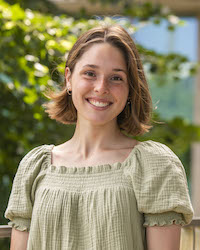 LinkedIn
LinkedIn
Educational Institution: University of Rhode Island
List of Mentors: Dr. John Wilson & Blaise Kimmel & Payton Stone
Program: NSF REU
Research Project: Synthesis of Tunable Protein-Polymersome Conjugates for Enhanced Targeting of Cancerous Tissues
Poster: NSF REU Lauren Hubert Poster
Research Abstract: Protein-polymersome conjugates have the potential to impact the field of immunoengineering leading to improved therapeutics via precise targeting and systemic monitoring. Here, we synthesized a library of diblock copolymers consisting of a first, polyethylene glycol (PEG) block, and a pH-responsive second block comprised of Dimethylaminoethyl methacrylate (DMAEMA) bound to an alkyl methacrylate chain. We subsequently utilized a rapid micro-mixing technique (flash nanoprecipitation) to generate an array of polymersomes. Polymer properties including second-block molecular weight and alkyl chain length were varied to optimize a polymeric nanocarrier capable of delivering therapeutics intracellularly. The polymer array was characterized based on size, cytotoxicity, encapsulation efficiency, potential for endosomal escape, hemolysis, and pH responsiveness to help reveal the polymer composition yielding the optimal polymersome. The tuned nanocarrier was then functionalized with an azide group on the PEG first block to enable future conjugation of immunotherapeutics.
We next synthesized a plasmid, encoding for a fusion protein containing mCherry and an antibody fragment for affinity targeting of an upregulated cancer antigen (GD2). We selectively ligated a single bicyclononyne (BCN) functional group onto the C-terminal of the fusion protein using an engineering Sortase A ligase in order to covalently link our fusion protein onto the azide-linked polymersome by strain-promoted alkyne-azide cycloaddition (SPAAC).
Our protein-polymer conjugate was confirmed via flow cytometry and fluorescence microscopy. The presence of mCherry will enable a future pilot study using In Vivo Imaging Systems (IVIS) to visualize the specific pathways taken by the protein-polymersome conjugates after systemic administration. Traditionally, polymersomes lack the ability to be systemically traced or target specific areas for intracellular delivery which limits their effectiveness as nanocarriers. Further, this study provides the basis for the future exploration of polymersomes linked to selectively ligated proteins allowing for enhanced functionality of these nanocarriers in biomedical applications.
Bio. Lauren Hubert is a rising junior, chemical engineering major on a pharmaceutical-focused track at the University of Rhode Island. She received the prestigious Thomas M. Ryan Scholarship from URI allowing her to become one of the seven members of the inaugural class of Ryan Scholars studying at the University with a full scholarship. She has completed 2 semesters of undergraduate research under Dr. Daniel Roxbury working on in vitro studies with a specific class of nanomaterials: single-walled carbon nanotubes. In that time, she has successfully applied for and obtained the (URI) 2 Undergraduate Research Grant and was published in ACS Applied Materials & Interfaces with the project titled: “Aggregation Reduces Subcellular Localization and Cytotoxicity of Single-Walled Carbon Nanotubes.” Over her two complete years at URI she has made the Dean’s List all four semesters, she was elected for an E-board position in the Sigma Gamma chapter of the professional engineering co-ed fraternity Theta Tau, and she has maintained memberships in both the American Institute of Chemical Engineers (AIChE) and the Society of Women Engineers (SWE). She hopes to continue working in the field of immunoengineering as she continues with undergraduate research and eventually pursues a PhD in chemical engineering.- Conference Presentation
-L.A. Hubert, B.R. Kimmel, P.T. Stone, H.M. Pagendarm, and J.T. Wilson "Synthesis of Tunable Protein-Polymersome Conjugates for Enhanced Targeting of Cancerous Tissues" American Institute of Chemical Engineering, Phoenix, AZ, November 2022
*awarded first place in division - Hubert was awarded a $1K travel grant at the capstone poster session.
- Watch Lauren's vlog where she shares her experience and view of the VINSE REU program.
- Conference Presentation
-
Emily Martinez - Materials Science and Engineering, University of Central Florida
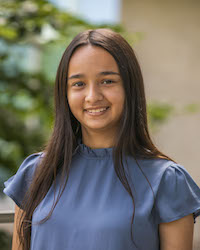 LinkedIn
LinkedIn
Educational Institution: University of Central Florida
List of Mentors: Dr. Kane Jennings & Marc Nabhan
Program: NSF REU
Research Project: Composite Films of Photosystem I Proteins with Substituted Polyanilines
Poster: NSF REU Emily Martinez Poster
Research Abstract: Photosynthesis is one of the most critical processes in nature, sustaining a wide array of living organisms by converting sunlight into chemical energy. The process of oxygenic photosynthesis relies heavily on four multi-subunit protein complexes, with one of these being Photosystem I (PSI). PSI proteins are photoactive, have a nearly perfect quantum yield, and bear electron-hole splitting capabilities at the P700 active site, but their lack of overall conductivity limits applications in solar conversion systems. Researchers have mixed PSI with various conducting polymers, including polypyrrole, polyaniline, and poly(ethylenedioxythiophene), to generate composite films that circumvent the challenge of poor conductivity. Still, these conducting polymers are mostly water-insoluble, are challenging to incorporate with PSI in an aqueous-based process, and have energies that may not align well with PSI’s active sites. In this work, we report the polymerization of two substituted anilines—p-anisidine and o-anisidine—in the presence of PSI in aqueous solution to form conducting polymer-protein composites. Since these are methoxyanilines, their processability in water as both monomers and polymers is greatly improved over the more common conducting polymers noted above. These composites can be easily drop-casted onto an electrode to form photactive, conductive films. Infrared spectroscopy shows that the final composite film contains both polymer and protein at a ratio that depends on the monomer-to-protein ratio in the polymerization solution. Contact angles were used to show that the composite film becomes more hydrophilic with increased ratio of polymer to protein. As ongoing work, the level of conjugation and intermolecular attraction between the protein and the resulting polymer will be examined using analytical ultracentrifugation, SDS-PAGE, and photoelectrochemical measurements of protein-polymer films. We will also examine if PSI can photooxidatively grow these polymers in a solution at neutral pH.
Bio. Emily Martinez is a rising junior at the University of Central Florida in Orlando, FL. She is majoring in Materials Science and Engineering and is also pursuing a minor in music, an area which she has been passionate about since childhood. She is a Florida Bright Futures Academic Scholar, a National Hispanic Scholarship recipient, and has been on the Principal’s List for all 4 semesters she has attended university. Outside of the lab, she demonstrates leadership in UCF’s choir ensembles, being the vice president of the chamber choir. She additionally contributes to her community as a member of the Society of women engineers (SWE) at UCF as well as being in the Burnett Honors College. At her home institution, she is a part of the NSF’s Partnerships for Research and Education in Materials (PREM) program as a research intern studying photocatalytic materials; in this program, she is gaining experience in research while also performing outreach activities to foster an appreciation for STEM and scientific research in younger students. She aims to go to graduate school to study chemical engineering and ultimately work in the renewable energy industry. -
Chiad Onyeje - Chemical Engineering, University of Maryland, Baltimore County
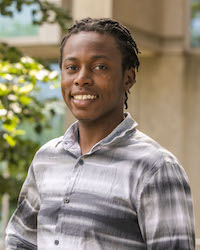
Educational Institution: University of Maryland, Baltimore County
List of Mentors: Dr. Criag Duvall & Carlisle DeJulius
Program: NSF REU
Research Project: Utilizing Microfluidics to Optimize the Formulation of Antioxidant Microparticles
Poster: NSF REU Chiad Onyeje Poster
Research Abstract: Reactive oxygen species (ROS) are a key driver of inflammation in degenerative diseases, and treatment strategies targeting ROS overabundance have shown promise in many studies. Sulfide-containing polymers (polysulfides) can scavenge ROS and can be formulated into drug-loaded microparticles for disease treatment. The classical method for particle formulation utilizes a bulk oil-in-water emulsion technique, with the polymer being introduced dropwise with the oil phase into the water phase. However, this technique is difficult to control and typically results in particles with large size variability. Thus, the introduction of microfluidic devices as a formulation process aims to provide a new method of polysulfide microparticle generation that can quickly and effectively produce batches at a controllably consistent size.
We have developed an in-house fabrication method utilizing customizable etched channels on a glass slide base. We flow the oil and water phases while harnessing droplet microfluidics to produce microparticles. This project focused on optimizing the flow rate and pressure in the device for particle production. We also tested various oil phase solvents (dichloromethane, chloroform, and ethyl acetate) for compatibility with the device. Finally, we compared the reactivity of microparticles formulated from two polysulfide derivatives in the presence of ROS via an overdosage of hydrogen peroxide (a common reactive oxygen species), demonstrating that the composition of the microparticle directly affects the rate of scavenging.
Bio. Chiad Onyeje is a biochemical engineering student at the University of Maryland, Baltimore County (UMBC). He currently attends the school as a member of the prestigious Meyerhoff Scholars program in its 31st cohort. Throughout his college career, Chiad has been delving deep into the research of the biological & chemical sciences. His projects have included a microscopy study on the brain tissue of ferrets performed before entered college, a concurrently running study on the development of nanoparticles to seal traumatic internal bleeding, and the currently presented development of microfluidic devices for microparticle formulation. His desire to seek out new horizons and understand the quickly growing field of nanotechnology has even led to a review paper’s publication early last year. Performing research at his home university of UMBC, The Johns Hopkins University, and now Vanderbilt University are testaments to his dedication towards seeking out answers in a field where questions begin. He is currently seeking new avenues to explore the biochemical and biomedical applications of engineering research, such as graduate school Ph.D. programs.- Conference Presentation
-C. Onyeje, B. Hanan, C. DeJulius, and C. Duvall "Utilizing Microfluidics to Optimize the Formation of Antioxidant Microparticles" Annual Biomedical Research Conference for Minoritized Citizens (ABRCMS), Anaheim, CA, November 2022 - Onyeje was awarded Best Use of Graphics at the capstone poster session.
- Conference Presentation
-
Gianna Paier - Biomedical Engineering, SUNY Binghamton University
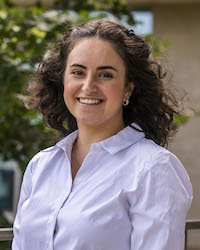 LinkedIn
LinkedIn
Educational Institution: SUNY Binghamton University
List of Mentors: Dr. Sharon Weiss & Simon Ward
Program: NSF REU
Research Project: Using Machine Learning with Porous Silicon to Determine IgG Concentrations in Human Serum
Poster: NSF REU Gianna Paier Poster
Research Abstract: The importance of accurate, robust, and cheap disease diagnostics has proven to be essential in modern society. However, many diagnostic techniques are only available in a clinical setting with trained personnel and expensive, bulky instruments, including the quantification of different protein levels in human serum. Elevated levels of certain serum proteins can indicate a variety of diseases. In this work, we investigate a new approach using a porous silicon material, optical reflectance measurements, and machine learning analysis, which could enable point-of-care serum protein testing. Porous silicon (PSi), fabricated by electrochemically etching nanoscale pores into silicon wafers, is a promising material to form the basis for small, cheap, and robust diagnostic tests. Physical properties of PSi pores, such as size and shape, can be tuned by changing the etching current density and duration. This determines how different molecules selectively enter and adsorb in the pores, which can be quantified by measuring shifts in optical reflectance spectra. Here, we explore which pore sizes most effectively separate Immunoglobulin G (IgG), one of the most abundant serum proteins, spiked in a healthy human serum control. We found that a current density of 80 mA/cm2 best discriminated IgG from other serum proteins, both in terms of optical response magnitude and kinetics. At the highest etching current density investigated (100 mA/cm2), which gives the largest pores, sensor response to IgG spiked serum was no different to the control, likely due to surface saturation. At the lowest studied current density (60 mA/cm2), which gives the smallest pores, there was negligible difference in response, since IgG is too large to enter the majority of the pores. To further refine the initial design of our sensor, we will study other characteristics that effect pore selectivity such as solvent pH and hydrophobicity. Data from the optimized PSi sensor will be fed into a machine learning algorithm to quantify IgG in serum. This approach can provide a convenient solution to many medical diagnostic challenges in the doctor’s office, or even at home.
Bio. Gianna Paier is a rising senior studying biomedical engineering with a concentration in biomedical devices at Binghamton University. Gianna spent her summer in the Weiss lab at Vanderbilt researching the development of point-of-care medical devices using porous silicon. In fall 2021, Gianna was inducted into Alpha Eta Mu Beta, the biomedical engineering honors society, and Tau Beta Pi, the engineering honors society. She will be acting as the secretary for Tau Beta Pi in the coming academic year. She was the Vice President of the Biomedical Engineering Society (BMES) for the past 2 years and was elected to be President for next year. Gianna is also an active member of Alpha Omega Epsilon, having been their historian, outreach, sisterhood, and professional chair. Gianna has also been a peer tutor through the Educational Opportunity Program (EOP) for the last year. She was a physics lab teaching assistant during the fall 2020 and spring 2021 semesters, where she led the class by performing scientific demonstrations and answering questions to cultivate students’ interest in the field. She is also excited to be a course assistant for the biomedical instruments and devices lab this coming semester under the guidance of Ammar Abdo. Gianna plans to pursue her PhD in biomedical engineering after she finishes her undergraduate education. She is grateful for her experience, and the people she met this summer for the support that guided her towards this decision.- Conference Presentation
-G. Paier, S.J. Ward, and S.M. Weiss "Using Machine Learning with Porous Silicon to Determine IgG Concentrations in Human Serum" Biomedical Engineering Society 2022 Annual Meeting, San Antonio, TX, October, 2022
- Conference Presentation
-
Nicholas Pugh - Mechanical Engineering, University of Maryland, Baltimore County
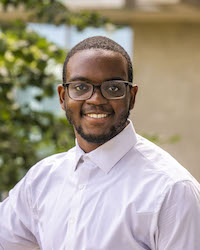 LinkedIn
LinkedIn
Educational Institution: University of Maryland, Baltimore County
List of Mentors: Dr. Deyu Li & Zhiliang Pan
Program: NSF REU
Research Project: Heat Transfer by Surface Phonon Polaritons in Silicon Carbide Nanowires
Poster: NSF REU Nicholas Pugh Poster
Research Abstract: Understanding thermal transport at the nanoscale level is crucial for maintaining the safe operation of modern electronic devices. It is well-established that electrons and phonons are the major energy carriers for thermal transport in metals and semiconductors/insulators, respectively. Recently, it has been suggested that surface phonon polaritons (SPhPs) could contribute to thermal transport in polar thin films and nanowires. SPhPs are energy carriers resulting from optical phonons coupling with surface electromagnetic waves. In this study, to evaluate the contribution of SPhPs to thermal transport, measurements of the thermal conductivity of a silicon carbide (SiC) nanowire were performed using a microthermal bridge method. Measurements of the thermal conductivity of the same sample with different suspended lengths, 22 µm 11 µm respectively, were first carried out. The overlapping thermal conductivity indicated negligible contact thermal resistance. Then, we introduce SPhPs into the SiC nanowires with the electron-beam induced deposition of platinum to probe the effect of SPhPs on thermal transport. A thermal conductivity enhancement of ~2% was obtained at room temperature. The enhancement becomes larger at low temperatures and eventually reached ~12% at 30 K. The temperature dependent behavior may originate from the stronger loss in SPhP propagation at elevated temperatures. This study provides experimental evidence of SPhP contribution to thermal transport in polar nanowires and inspires a revisit of the effect of EBID treatment on thermal transport in polar materials.
Bio. Nicholas Pugh is a rising sophomore attending the University of Maryland, Baltimore County (UMBC) as a mechanical engineering major. At UMBC, Nicholas is a member of the 33rd cohort for the Meyerhoff Scholars Program and a member of the Honors College. He has been placed on the Dean’s list for the Fall 2021 and Spring 2022 semesters at UMBC for academic achievements. Nicholas is also a member of the American Society for Mechanical Engineers (ASME) and the National Society of Black Engineers (NSBE). This summer Nicholas is participating in a ten-week research experience at Vanderbilt University in Dr. Deyu Li’s Lab studying nanoscale thermal transport. He is excited to continue his research career in the upcoming years and prepare a path toward obtaining his Ph.D. -
Sarah Shibuya - Biomedical Engineering, Rose-Hulman Institute of Technology
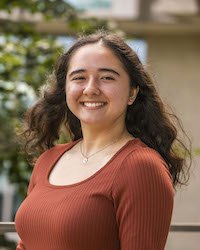 LinkedIn
LinkedIn
Educational Institution: Rose-Hulman Institute of Technology
List of Mentors: Dr. Mike King & Jenna Dombroski
Program: NSF REU
Research Project: Selective Functionalization of Leukocyte Subpopulations with E-Selectin Liposomes
Poster: NSF REU Sarah Shibuya Poster
Research Abstract: Metastasis occurs when cells break off a primary tumor and enter the blood stream. This process can create secondary tumors at distant sites. To combat metastasis, an antimetastatic therapy uses the protein TNF-related apoptosis inducing ligand (TRAIL) to initiate apoptosis in circulating tumor cells (CTCs) in the blood stream. Liposomes with the protein E-Selectin (ES) attach to leukocytes in the bloodstream and are used as vessels to transport TRAIL to CTCs. Here, we investigate the influence that ES has on the binding of liposomes to subpopulations of leukocytes, specifically monocytes and granulocytes. Through flow cytometry analysis of monocytes and granulocytes from healthy patient blood, the concentrations of fluorescent ES-liposomes bound to the surface of these cells were investigated. It was found that as the average number of ES per liposome increases, the greater occurrence that liposomes are bound to granulocytes. The number of ES yields no correlation on the effect of liposome-monocyte binding. The influence of the liposome component DSE-PEG was also investigated. When DSPE-PEG was removed from the liposome fabrication process, a specific subpopulation of higher fluorescence in flow cytometry measurements indicated more efficient binding to granulocytes. Imaging using fluorescence microscopy visually confirmed the binding of liposomes without DSE-PEG to leukocytes using a DiI lipid dye and DAPI nuclei dye. A population of granulocytes did not bind to these liposomes, while most were bound to them in abundance, indicating there may be selective binding to specific types of granulocytes. There was little to no binding to monocytes with 0 ES, but with ES present, binding was found to occur to select monocytes. High binding to platelets was found in both leukocyte populations. The investigation of this topic can yield better results in the utilization of liposomes as a delivery system for TRAIL in antimetastatic therapies.
Bio. Sarah Shibuya is a rising sophomore at Rose-Hulman Institute of Technology from Portland, Oregon. She is majoring in biomedical engineering with a focus in biochemistry and molecular biology. Sarah is a Commitment Scholar and a part of the Noblitt Scholars Program. She belongs to the Biomedical Engineering Society, the Society of Women Engineers, and is a player on the Rose-Hulman Women’s Soccer Team. She earned her Silver Award through Girl Scouts and continues to be a part of scouting through the Alpha Phi Omega service fraternity. In her free time, she loves to crochet, read, and enjoy nature. Looking into the future, Sarah plans to attend graduate school to study biology or biomedical engineering.- Conference Presentation
-S.A. Shibuya, Z. Zhang, J.A. Dombroski, and M.R. King "Selective Functionalization of Leukocyte Subpopulations with E-Selectin Liposomes" Biomedical Engineering Society 2022 Annual Meeting, San Antonio, TX, October, 2022 - Shibuya was awarded a $1K travel grant and NCUR nomination at the capstone poster session.
- Conference Presentation
-
Trey Theobald - Biochemistry, Ohio Wesleyan University
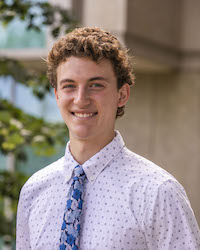 LinkedIn
LinkedIn
Educational Institution: Vanderbilt University
List of Mentors: Dr. Ethan Lippmann & Andrew Kjar
Program: NSF REU
Research Project: Identifying Early Developmental Neurotoxicity Modeled in a Cerebral Organoid System
Poster: NSF REU Trey Theobald Poster
Research Abstract: Pregnant individuals are typically excluded from traditional clinical trials due to ethical and safety concerns for the fetus. This lack of data leads to challenges in managing the health concerns of the expectant patient while also protecting the developing fetus from neurologically damaging medications. To be able to effectively understand how certain medications impact fetal neurodevelopment, alternative screening methods for neurotoxicity are essential. Here, we provide a scalable, human specific model for neurological drug toxicity screening using human induced pluripotent stem cell derived cerebral organoids that model the growth and layering of the developing fetal brain. In control organoids, neural progenitors (SOX2+/PAX6+) comprised the center of the tissue while mature neurons (ßIIIT+/TBR1+) formed the outer surface. We tested gabapentin for neurotoxicity using folic acid and valproic acid as controls to verify the sensitivity of our system. Size and shape characterization over 30 days revealed that folic acid and gabapentin drug concentration did not affect the growth kinetics of organoids while organoids dosed with valproic acid exhibited a decreased growth rate at a concentration of 10 mM. Secondary cell titer assays revealed decreased viability in organoids with high concentrations of valproic acid, confirming the size characterization. Preliminary spinning disc confocal imaging indicated that organoids dosed with 10mM valproic acid exhibited few ßIIIT+ cells. Future development of our high throughput screening organoid model will provide an ethical and efficient method of evaluating neurotoxicity for early developmental and fetal populations.
Bio. Trey Theobald is a sophomore in the Honors Program at Ohio Wesleyan University majoring in biochemistry. Trey is a sprinter and thrower on the track team and was named Ohio Wesleyan's 2022 Most Outstanding Freshman. He is active in the health science community on campus and serves as the treasurer of the Ohio Wesleyan Health Sciences Club. This summer Trey is working in Dr. Ethan Lippmann’s lab with his graduate student mentor Andrew Kjar to develop an early developmental neurotoxicity screening technique using cerebral organoids. Trey would like to thank Andrew, Dr. Lippmann, and the rest of his research team for their guidance and direction throughout the summer. The collaborative nature of the VINSE program has inspired Trey to pursue the possibility of future research. Finally, Trey is grateful for the experience he has had this summer with the VINSE staff as well as the rest of his cohort both within and outside of the laboratory.- Conference Presentation
-T. Theobald, A. Kjar, and E. Lippmann "Identifying Early Developmental Neurotoxicity Modeled in a Cerebral Organoid System" Biomedical Engineering Society 2022 Annual Meeting, San Antonio, TX, October, 2022
- Conference Presentation
-
Andrea Valero - Chemical Engineering, University of Texas, San Antonio
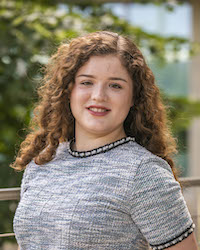 LinkedIn
LinkedIn
Educational Institution: University of Texas, San Antonio
List of Mentors: Dr. Cynthia Reinhart-King & Jenna Mosier
Program: NSF REU
Research Project: Using a Microtrack Platform to Determine the Effect of Reactive Oxygen Species on Confined Migration
Poster: NSF REU Andrea Valero Poster
Research Abstract: Tumor heterogeneity remains a clinical challenge in cancer treatment as it drives differential responses of cancer cells subpopulations to various environmental cues. Both mechanical cues, such as confinement, and metabolic cues, such as levels of metabolic intermediates like reactive oxygen species (ROS), have been shown to promote cell invasion and migration. To understand the role of heterogeneity in breast cancer cell behavior, we previously sorted MDA-MB-231 triple negative breast cancer cells (MDA) into highly (MDA+) and weakly (MDA-) migratory subtypes and assessed their differential response to metabolic cues. We found that treatment with high doses of the ROS activator, tertbutylhydroperoxide (TBHP), significantly decreased speed in both subtypes, in contrast with previous reports. Here, we aim to better understand how ROS production contributes to breast cancer cell migration. To investigate the effect of ROS, collagen microtracks were formed using polydimethylsiloxane (PDMS) stamps to mold collagen into tunnels that mimic the tumor matrix. Parental MDA-MB-231 cells seeded into the microtracks and cells were treated with 25 μM, 50 μM, and 75 μM concentrations of TBHP and migration speed was assessed. We observed that when treated with 25 μM TBHP, a fraction of the parental cells slightly increased migration velocity, suggesting that ROS may have differential effects on different cell subtypes at low doses. Metabolic dysregulation is a primary driver of metastasis and understanding the contribution and influence of ROS on breast cancer cell migration is pivotal to understanding how to target metastasis.
Bio. Andrea Valero is a rising sophomore studying chemical engineering at the University of Texas at San Antonio. She has research experience in neurodegenerative diseases, wind energy optimization, drug delivery systems, and cancer cell migration. Her passion for research have earned her a position in the ESTEEMED, a NIH/Federally-funded program that helps freshman and sophomore-level trainees develop as scholars and scientists. During her freshman year, she became an undergraduate researcher under the supervision of Dr. Gabriela Romero, where she works independently in the experimentation and data analysis of polymers for drug delivery. At her home institution, she exerts a leadership role as the Senator for the College of Engineering and as part of the Presidential Student Advisory Council. Additionally, she is part of Society of Women Engineers and the UTSA SACNAS Chapter. Due to her academic achievement, she has earned her a place on the Dean’s List and as a Klesse Scholar. This summer, she is working under the supervision of Jenna Mosier and Dr. Reinhart-King to understand the behavior of breast cancer cells and the effect of reactive oxygen species on confined migration. Her professional aspirations are to obtain a PhD and become a biomedical innovator.- Conference Presentation
-A. Valero, Q. Xing, R. Padmanabhan, J.A. Mosier, C. Reinhart-King "Using a Microtrack Platform to Determine the Effect of Reactive Oxygen Species on Confined Migration" SACNAS National Diversity in STEM Conference, San Juan, Puerto Rico, October, 2022
*awarded outstanding poster
- Conference Presentation
